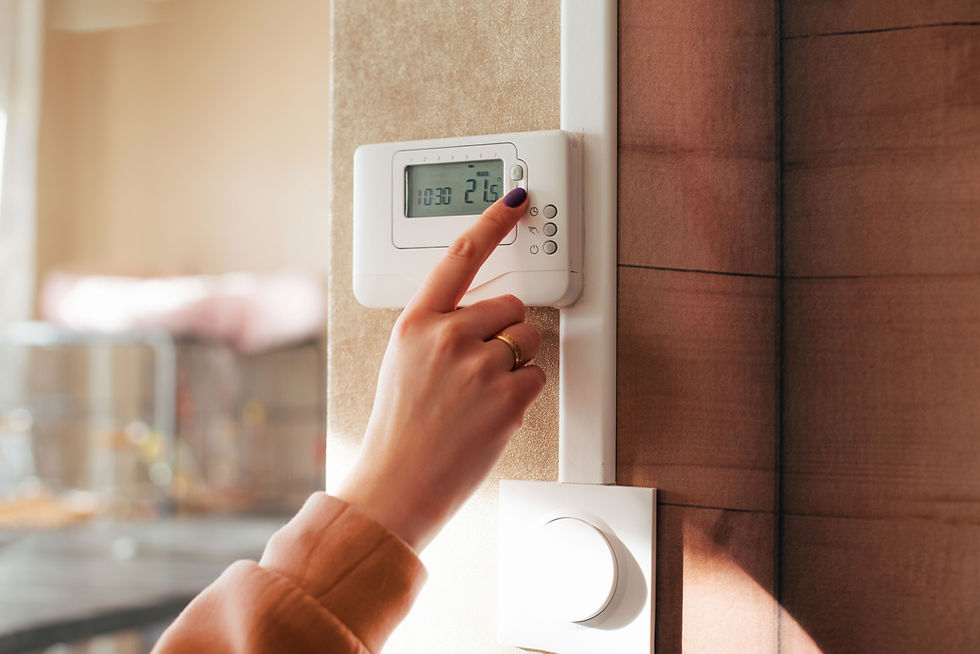Air-Conditioning HVAC Equipment Guide for Architects
- Architect Dennis

- Nov 19, 2024
- 3 min read
Updated: Nov 20, 2024
Air-conditioning equipment represents one of the most critical components in modern building design, accounting for approximately 40% of building energy consumption in commercial structures. The proper selection, sizing, and implementation of these systems directly impacts occupant comfort, energy efficiency, and building operational costs. HVAC Equipment Guide for Architects

Core Functions of Air-Conditioning Systems
Temperature regulation
Humidity control
Air filtration and purification
Ventilation management
Indoor air quality maintenance
Overview of Air-Conditioning Equipment
Definition and purpose
Modern air-conditioning systems serve multiple functions beyond simple cooling:
Temperature Control
Cooling capacity ranges from 5,000 BTU for small rooms to millions of BTU for large facilities
Precise temperature regulation within ±1°F in advanced systems
Zone-specific temperature management capabilities
Humidity Management
Optimal indoor humidity range: 40-60%
Moisture removal through condensation
Integration with dedicated dehumidification systems when needed

Modern air-conditioning systems serve multiple functions beyond simple cooling
Historical evolution of air-conditioning technology
The development of air-conditioning technology has transformed building design:
Early Systems (1900-1930)
Industrial applications focused on process control
Carrier's first modern air-conditioning system (1902)
Limited to theaters and industrial facilities
Mid-Century Developments (1930-1960)
Introduction of residential systems
Development of refrigerant technology
Standardization of comfort criteria
Modern Era (1960-Present)
Digital control systems
Variable refrigerant flow technology
Smart building integration
Energy efficiency focus

Types of Air-Conditioning Equipment -HVAC Equipment Guide for Architects
Window air conditioners
Technical Specifications:
Capacity: 5,000-24,000 BTU/hour
Typical EER: 10-12
Single-package design
Integrated controls
Applications:
Small offices
Residential rooms
Retrofit projects
Temporary facilities
Design Considerations:
Structural Support
Window frame reinforcement
Wall penetration details
Waterproofing requirements
Aesthetic Impact
Façade appearance
Visual integration
Screen options
Split-type systems
Components and Configuration:
Indoor Unit
Evaporator coil
Air handler
Condensate management
Filter system
Outdoor Unit
Compressor
Condenser coil
Fan system
Control board
System Variations:
Mini-Split Systems
Capacity: 9,000-36,000 BTU/hour
Single zone coverage
Wall-mounted, ceiling-mounted, or floor-standing options
Multi-Split Systems
Multiple indoor units (up to 8)
Individual zone control
Capacity up to 60,000 BTU/hour
VRF/VRV Systems
Large commercial applications
Simultaneous heating and cooling
Advanced control capabilities
Heat recovery options
Central air-conditioning units
System Types:
Packaged Units
All components in single cabinet
Roof or ground mounting
3-20 ton capacity range
Split Systems
Separate indoor and outdoor sections
Flexible installation options
Common in residential applications
Chilled Water Systems
Central plant configuration
Multiple air handlers
Large capacity applications
Design Requirements:
Space Planning
Mechanical room sizing
Equipment clearances
Service access
Ductwork routing
Structural Considerations
Floor loading capacity
Vibration isolation
Seismic restraints
Roof reinforcement

Portable air conditioners
Characteristics:
Capacity: 8,000-14,000 BTU/hour
Self-contained design
Mobility features
Temporary installation
Applications:
Supplemental cooling
Emergency backup
Construction phases
Event spaces
Factors to Consider When Choosing Air-Conditioning Equipment
Cooling capacity (BTU)
Load Factors:
Space Characteristics
Square footage
Ceiling height
Window area
Insulation values
Internal Heat Sources
Occupancy levels
Equipment loads
Lighting systems
Process loads
External Factors
Climate zone
Solar orientation
Building envelope
Adjacent spaces

Energy efficiency ratings (SEER and EER)
Rating Systems:
SEER (Seasonal Energy Efficiency Ratio)
Minimum requirements by region
Typical range: 13-21
Cost implications
Energy savings calculation
EER (Energy Efficiency Ratio)
Peak load efficiency
Standard rating conditions
Comparison metric
IEER (Integrated Energy Efficiency Ratio)
Part-load performance
Seasonal variations
Operating cost analysis
Space requirements and installation constraints
Space Considerations:
Physical Dimensions
Equipment footprint
Service clearances
Access requirements
Future replacement
Location Factors
Noise impact
Vibration control
Visual exposure
Maintenance access
Energy Efficiency and Environmental Impact
Innovations in energy-saving technologies
Advanced Features:
Variable Speed Technology
Improved part-load efficiency
Better temperature control
Reduced energy consumption
Lower operating costs
Smart Controls
Occupancy sensing
Learning algorithms
Remote management
Predictive maintenance
Heat Recovery Systems
Energy recapture
Simultaneous heating/cooling
Reduced operating costs
Refrigerants and eco-friendly alternatives
Current Standards
R-410A systems
Phase-out schedules
GWP regulations
Safety requirements
Future Trends
Natural refrigerants
Low-GWP alternatives
Regulatory compliance
Industry transitions
Maintenance and Longevity of Air-Conditioning Equipment
Regular cleaning and servicing
Maintenance Schedule:
Monthly Tasks
Filter inspection
Condensate check
Operating parameters
Visual inspection
Quarterly Service
Coil cleaning
Belt inspection
Electrical checks
Performance testing
Annual Maintenance
Comprehensive inspection
Component testing
Refrigerant levels
Safety checks
System Longevity
Life Cycle Considerations:
Expected Lifespan
Window units: 10-15 years
Split systems: 15-20 years
Central systems: 20-25 years
Component variations
Replacement Planning
Equipment access
Technology updates
Energy efficiency
Cost analysis

Conclusion
The successful implementation of air-conditioning equipment requires careful consideration of multiple factors, from initial system selection to long-term maintenance requirements. Architects must balance technical requirements with aesthetic considerations while ensuring optimal performance and energy efficiency. Understanding these various aspects enables informed decision-making in the selection and implementation of air-conditioning systems in architectural projects.
The future of air-conditioning equipment continues to evolve with emerging technologies, increasing energy efficiency requirements, and environmental regulations. Staying current with these developments while maintaining focus on fundamental design principles ensures successful project outcomes.
Learn more related topics from our well curated reference from Amazon. Head over to our Resource Page




Comments